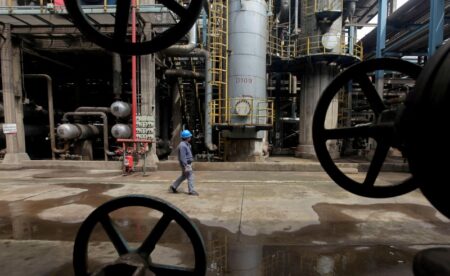By Ernest Scheyder and Clara Denina
(Reuters) -Rio Tinto has been holding talks to buy lithium miner Arcadium, three sources with direct knowledge of the negotiations said, a deal that would make Rio the third-largest producer of the electric vehicle battery metal.
Arcadium shares surged 36% in extended trading on Friday.
Talks have been ongoing and continued in London this week during the LME Week conference, one of the sources said. An offer is expected to come in the near future, according to the second source. Talks are ongoing and may not necessarily result in a deal, the sources said.
Philadelphia-based Arcadium could be valued between $4 billion to $6 billion or higher, the third source said. None of the sources were authorized to discuss the negotiations publicly.
The deal would vault Rio into one of the world’s largest suppliers of the ultralight metal, behind only Albemarle (NYSE:) and SQM, just as demand is expected to surge later this decade amid growing use of lithium-ion batteries for EVs and consumer electronics.
The recent slump in lithium prices, which is due in part to Chinese oversupply, has pushed Arcadium’s shares down more than 50% since January, making it an attractive takeover target.
It was not immediately clear if a transaction would primarily include cash, stock or a mixture of both. Arcadium has selected two investment banks to handle its negotiations with Rio, according to the second source.
By buying Arcadium, Rio would gain access to lithium mines, processing facilities and deposits across four continents to fuel decades of growth, as well as a customer base that includes Tesla (NASDAQ:), BMW (ETR:) and General Motors (NYSE:).
Arcadium and Rio Tinto (NYSE:) declined to comment.
The Anglo-Australian mining company is already one of the world’s largest producers of – used to make wiring, construction equipment, electronics and other devices – as well as iron ore and other metals.
Arcadium has around 2,400 employees across nine countries. Roughly 84% of its revenue comes from Asia – the existing global center for lithium demand – giving it growth potential as EV projects ramp up across the Western Hemisphere, especially those supported by the U.S. Inflation Reduction Act.
Rio faces strong opposition in Serbia to its proposed Jadar mine, for which it recently regained its license. Local community members have repeatedly pressured Belgrade to block the project, which has the potential to supply much of Europe’s needs of the battery metal.
Arcadium believes it is unlikely Rio will ever be able to develop the Serbian project, the second source said.
Rio could also benefit from Arcadium’s expertise in direct lithium extraction, a growing segment of the lithium industry that aims to mechanically filter the metal from brines.
No company has commercially launched a DLE process without evaporation ponds, but Arcadium has successfully been using DLE since the 1990s with ponds in Argentina and its engineers are widely seen as global experts.
Rio paid $825 million in 2022 for a DLE project in Argentina that has yet to produce the metal.
‘THE FULL PACKAGE’
Arcadium was formed only in January by the merger of U.S.-based Livent (NYSE:) and Australia-based Allkem, with each company getting an equal number of slots on the company’s 12-person board of directors.
Speculation of a potential tie-up between Arcadium and Rio has floated for weeks.
“Arcadium offers Rio the full package,” Scotiabank analysts said on Sept. 10, adding that “the case (for a buyout) has strengthened.”
At a presentation to investors on Sept. 19, Arcadium laid out an aggressive growth strategy to nearly triple its adjusted earnings by 2028 by developing its lithium projects across the globe.
Rio’s interest in Arcadium comes amid a rising wave of deal interest across the mining industry, especially for critical minerals needed to power the global energy transition.
BHP – the world’s largest miner – earlier this year made an unsuccessful bid for smaller rival Anglo American (JO:). Glencore (OTC:), BHP and others are seen as potential bidders for other critical minerals projects.
Read the full article here
















